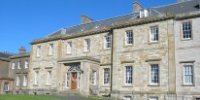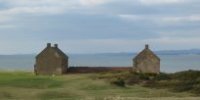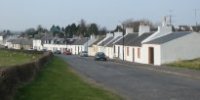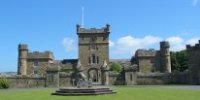Newton upon Ayr
[Vol. II pages 262–274]
By the Rev. Mr Peebles
Origin of the Name
In the charters granted to this burgh, Newton, is called Nova ville de, or more commonly Super Air. It is now generally known, by the name of Newton upon Ayr. It evidently derives that appellation, from its vicinity to the adjacent royal borough. Though built at a later period, it appears, that Newton originally possessed, as it still does, distinct and independent privileges, and hence it is called, not the Newton of Ayr, but Newton upon the banks of the river of that name.
Situation and Extent
Newton lies in the county, presbytery, and synod of Ayr. It was at first included in the parish of Prestick [sic], but was erected into a separate parish in 1779. Its extent is very inconsiderable, not above a mile and a half in length, and a mile in breadth. It is bounded by the parishes of Prestick and St Quivox, and, in every other quarter by the river Ayr, and the sea.
The Burgh
Newton is a burgh of barony, or regality, [263] holding directly of the king. By whom it was erected, is uncertain, as the original charters are lost; but tradition says, that Robert I who, in his old age, was seized with a scrophulous, or leprous disorder, granted Newton and Prestick the privileges they now enjoy, in consideration of the kindness shown him upon the occasion of his illness. The same king, it is also said, endowed an hospital for old infirm people, called King's Case, which still exists, and is situated near the boundary of this parish. The oldest paper in the custody of the community of Newton, is dated in 1574, and contains a short precept, directed to the two baillies of the burgh, empowering them to exercise authority in the town; but there is no signature affixed to it. All the privileges, formerly given to the borough, were renewed by James VI of Scotland, and I of England, by a charter, dated the 24th of September 1595; and another charter, to the same effect, was granted, about 5 years after.
In these charters, no mention is made of the internal regulation of the burgh; but from antient and constant usage, its constitution has acquired certain peculiarities. The number of freemen or burgesses, is limited to 48, which compose the community. Each of these freemen possesses, what is called, a lot or freedom, containing about 4 acres of arable land; besides the common, on which the burgesses have an exclusive right to pasture their cattle. No houses are annexed to these freedoms; but every burgess must reside in the burgh, or possess a house as his property, which he may rent to any of the inhabitants. The community meet every two years to elect their magistrates; and, at this election every freeman has a vote. They choose two baillies, one treasurer, and sic counsellors, who have the management of every thing belonging to the burgh; but on urgent occasions, they call meetings of the community. Of late, little or nothing has been done without [264] taking the sense of the freemen. This method, however, on account of their numbers, is sometimes a hindrance to business. The accounts of the treasurer are open to the inspection of every freeman, and he is accountable to the community at large. The right of succession to their freedoms is limited. A son succeeds to his father; and a widow, not having a son, enjoys the property of her husband as long as she lives. But as the female line is excluded, the lots or freedoms frequently revert to the town, who dispose of them to the most industrious inhabitants of the place, on their advancing a certain sum of money, which is placed in the public fund. Each freedom is valued at £25, though none have given so much for it. The common revenue of the burgh, exclusive of these freedoms, is small. It arises from certain feu duties; the rent of a mill, a ropework, some carpenters yards, and other small properties, which produce about £60 per annum; but of late years, they have derived considerable profit from the coal works in their estate. This fund, however, is precarious, and uncertain.
The Town, its Grounds, and Surface
The town principally consists of one large street, about 680 yards in length, and about 80 feet in breadth. It is unfortunately incumbered near the bridge, with a mill, &c the removal of which, would be a great convenience and improvement. There are three other streets in the parish, but their extent is not great. In that part of it, called Garden–street, there formerly stood a large dwelling–house, denominated Newtoncastle, which was, for along time, the property of the Wallaces of Craigie; but now some part of the wall, which inclosed the garden, alone remains. Thirty houses have been built in the town within these thirteen years; but ten of them on old foundations.
[265] The greatest part of the ground, belonging to the community, is a dead level, lying to the east, and north–east of the town. The soil is a light blowing sand, so that the land, along the coast to the north–east, wears a gloomy appearance. It might be meliorated, by rearing plantations of Scots fir, and of the larix, but, above all, of the pineaster [sic], which is called the maritime pine, from its thriving so near the sea. No durable inclosures can be made but at great expence. The more inland part is rather of a better soil, with a stratum of moss on the surface. It was once a morass, but was drained many years ago at some expence. By this drain, the water is conveyed, that serves the mill, belonging to the community. A plan of all their grounds was drawn up sometime ago by the Town–Council; and another was lately executed by the company, who rent their coal. The arable ground consists of above 200 acres, and the common about 150. The whole is valued in the cess–books at £117 Scots, and the property is estimated to be worth in all £4000 Sterling. From the nature of the soil, which is mostly a bed of blowing sand, to a considerable depth, the ground is far from being fertile; it requires constant manuring to render it moderately productive. The best and most profitable crop is rye–grass and clover. Oats and bear are the grains commonly sown. The seed–time for oats, is from the middle of March to the middle of April: and that for barley, from the 20th of April, to the 25th of May. It is thought, that the inhabitants sow their grain much too late. Rye is sometimes cultivated with advantage; but this crop impoverishes the ground. Sea–weed is found to answer as manure; but the quantity cast on the shore is not great. The soil, in tolerable seasons, produces excellent potatoes. The whole parish is open and unsheltered. Not a tree to be found, and no thorn hedges of any growth, owing to the violence of the westerly winds, which often blow [266] severely on this coast, during the winter season. The property of the borough, however, might be much improved, and its value greatly increased. The only public road, is the high way leading through Prestick, to Kilmarnock and Glasgow, which is always kept in tolerable repair. On this road there are two turnpikes within the parish; one of which rents at £100, and the other at £285 per annum.
Population of the Parish
Not above a century ago, Newton contained few inhabitants; probably from 300 to 400. Within the lst 40 years, the number has greatly increased. This increase was chiefly owing to an extensive herring fishery, at that time, carried on along this coast, particularly near the mouth of the river, which continued upwards of 15 years. When the coalleries [sic] on the Newton and Blackhouse lands began, the number of inhabitants still increased. In the year 1778, when the present incumbent made his first parochial visitation, the number from 7 years of age, and upwards, was 1200; and that of souls, 1600. Since that time, no enumeration of souls hath been taken. For some years afterwards, the number rather decreased, owing to the failure of the coal–works. But since these have been resumed, which was about 5 years ago, the number has been increasing. At the last visitation, in summer, 1790, there were found 1350 persons, from 7 years and upwards: of these, 610 were males, and 740 females; the number of families amounting to 380; the number of souls to about 1750. The following is a statement of the births and marriages, for the last 10 years [267]:
Abstract of Births and Marriages |
|
Years |
Births |
Marriages |
|
1781 |
46 |
10 |
|
1782 |
53 |
11 |
|
1783 |
40 |
13 |
|
1784 |
44 |
7 |
|
1785 |
40 |
6 |
|
1786 |
36 |
20 |
|
1787 |
43 |
13 |
|
1787 |
43 |
13 |
|
1788 |
57 |
20 |
|
1789 |
48 |
12 |
|
1790 |
58 |
17 |
|
|
465 |
129 |
From the above statement, the number of births, at an average, amounts to above 46, and of marriages, about 13 annually. No exact account can be given of the number of deaths, as no proper burial ground has been allotted for the use of the inhabitants: the greatest part burying in Prestick or Ayr, in St Quivox, and the burying ground belonging to the Seceding meeting-house, in the parish of St Quivox. Burial–ground is much needed; which the community might provide at a small expence, by inclosing a part of their waste land, in the vicinity of the town. The number of deaths is supposed to amount to 30, annually. The whole of the inhabitants belong to the Established Church, a few families excepted, (about 12 in all), who are mostly of the sect, called the Antiburgher Seceders.
Eccliastical State of the Parish
The next article, that [268] deserves attention, is, the erection of Newton into a separate parish. The borough lying at the distance of 3 miles from Monkton, formerly the parish church, where the inhabitants had little or no accommodation, the community, from the funds of the town, generously built the present house for public worship, in the year 1777, which was at first established with the consent of the presbytery, on the footing of a chapel of ease. Finding this plan attended with some disadvantages, the community, in the year 1778, applied to the Lords Commissioners for plantation of kirks, and valuation of tiends, to have their town disjoined from the united parishes of Monkton and Prestick, and erected into a separate parish. In consequence of this application, they obtained a decreet for that purpose in 1779; having previously purchased the right of patronage to their church, from the patrons of the united parishes of Monkton and Prestick. By the above decreet, it is established, that the community shall choose, every year, 13 of their number to manage the secular affairs of the church, who are styled delegates. When a vacancy takes place, these 13 delegates have the sole power of electing a pastor, and of granting a presentation, with this proviso, that 9 of the 13 must be unanimous in the choice.
The stipend, at first, amounted only to £65; but it has since received an addition of £10 per annum, in lieu of the coal below the glebe. In 1780, the town granted a glebe of 4½ acres; part of which is now occupied by the manse and garden. The ground being poor, and of a light sand, it rented, before the manse was built, only a 5 guineas per annum, though in the vicinity of a populous place. All that is allowed for grass, is the liberty of keeping a cow, and her follower, on the common belonging to the town. The glebe is not well inclosed, which lessens its value. The melioration of glebes by inclosing, which has been under the consideration of [269] the General Assembly, deserves every possible encouragement. A manse was first built in 1787. A house is also appropriated for the parish school. The number of scholars that attend it, is from 40 to 50. The wages are 2s per quarter for English; 2s 6d for writing; and 3s for arithmetic. There are some private schools in the town; and a few of the in habitants send their children to the schools of Ayr, being almost equally near.
Poor of the Parish.
Owing to the want of manufactures of every kind, and to the constant influx of beggars from Ireland, few places, in proportion to their extent, are more distressed with poor than this parish. Many of them, indeed, who reside only a short time in the place, can lay no legal claim to supplies from the kirk–session, but they are still a burden to the inhabitants, by their begging from door to door. The number of monthly pensioners is daily increasing, while the only fund, to be distributed among them, is small and precarious. There is no fund indeed, for the purpose, but what arises from collections at the church doors, on Sundays, and sacramental occasions, amounting in whole to £50 per annum. At present there are 18 pensioners on the poors roll, each of which receives from 2s to 4s 6d per month; besides others who are supplied occasionally. No stent or tax has been laid on the inhabitants for the support of the poor; but if their demands continue to increase, as they have done for several years past, that measure will soon become unavoidable. Attempts have often been made to establish regulations, concerning the poor in this part of the country,, but, from various causes, they have proved unsuccessful.
Coal
A considerable quantity of coal is found in the grounds belonging to the community, and has been wrought [270] for many years. It was rented from the town, at £250 per annum; but the work was abandoned about 10 years ago, and the lease was consequently broken. It was resumed in 1786, by a company of respectable gentlemen at Edinburgh, and has ever since been carried on with success. The tacksmen pay a duty of 6d to the town for every tun they raise. The first 3 or 4 years, the town's profits amounted to above £300 per annum, which makes the number of tuns above 1200 yearly, but, for the two last years, the produce has not been so considerable. The greatest part of the coal is shipped for Ireland. The present company, at some expence, have made a waggon way from the pits to the harbour, the road reaching to the key, which renders it exceedingly convenient for loading vessels. The price of the coal is 5s 6d per tun, each tun weighing 24 cwt. The quantity of water in the pits is so considerable, that it was found necessary to erect a large steam engine. The pumps are of 14 inches bore; and the quantity of water discharged is 36 gallons at each stroke, the stroke being repeated about ten times in the minute, or 360 gallons in the minute. This discharge continues 20 hours in the 24. There are tow seams of coal, about 4 feet thick each, the upper seam is 30 fathoms deep from the surface; the greatest part of which near the town, is already wrought. The lower seam, which is 20 fathoms deeper than the upper, is still untouched. No probable conjecture has been formed, what quantity of coals remain in the grounds of the community. There is another coal pit in the parish, belonging to a private individual, wrought by the above tacksmen, for which, they pay a duty of 10d per tun; but it is of small extent, and will soon be exhausted. The coal in the Blackhouse grounds, in the neighbourhood, being in the parish of St Quivox, comes not within the limits of this description.
[271]
Harbour
Newton upon Ayr is a sea–port town; the north east side of the river, lying in the parish, which, with the other side in the parish of Ayr, forms the harbour. The town, like that of Ayr, is situated at a small distance above the place where the vessels ly [sic]. A few houses, of late, have been built nearer the quay. The entrance to the harbour has always been precarious, by reason of a bank at the mouth of the river, formed chiefly by the sand that is carried down the river by land floods; of late years, the access has been still more difficult. The bed of the river is narrow, and the depth of water, at spring tides, not above 12 feet; so that vessels, exceeding 140 tons, register burden, cannot be brought over the bar. In December, 1789, considerable damage was done to the shipping of this place; no less a number than 12 vessels, in one night, were stranded, some to the south, and others to the north of the harbour; one of them was totally wrecked, and all the hands in it perished: several men, on board the other vessels, at the same time, lost their lives. This deplorable calamity pointed out the necessity of erecting a light–house. The design was accordingly carried into execution, by the gentlemen who rent the coal belong the community. At their own expence, they erected, last year, two reflecting lights, both of which stand on the north–east side of the harbour, in this parish. A small duty is paid by each vessel for maintaining them. [272] Though these lights were only erected in October, 1790, they have already been found very beneficial. The greatest attention has been paid to them, so that no accidents have happened through neglect.
The principal trade carried on at present, in the harbour, is the exportation of coal. For four years past, above 300 vessels have been annually loaded with coal, which go to Dublin, Belfast, Learne, and other places in Ireland [sic]. A few vessels are also employed in bringing fir in logs, and plank, from Memel, and other parts in the East seas. Since the annexation of the Isle of Man to the Crown, and particularly since the late acts of parliament concerning smuggling, any species of illicit trade is now little practised in this, or in any other part of the neighbourhood. There are two packet boats to Greenock, one to Liverpool, and sometimes one goes to Campbleton [sic]. No regular stated communication has hitherto been formed between this port and London.
Shipbuilding and Ropework
For many years past, shipbuilding has been carried on at this harbour, but it is only of late, that this branch has met with any particular encouragement. By the activity and diligence of some individuals in the parish, a number of vessels have been constructed, and the business seems to proceed with spirit and vigour. It is carried on chiefly on this side of the river, as affording many more conveniences that the other. Fifty hands are employed in this branch of business, whose wages are from 20d to 22d per day. Oak wood is brought from England and Wales, fir from Dantzick [sic]: [273] the extent of the trade, at this time, will be about £5000 per annum.
The only rope–work in the neighbourhood is on this side of the river. Some years ago, little was done in this line; but it is now beginning to revive. Ten hands are employed in manufacturing ropes. The extent of the business is from £1500, to £2000 per annum. The hemp is imported from Peterburgh.
Fisheries
A salmon fishing is carried on at the mouth of the river, and along the coast, as far as the parish extends, to the northward. This fishing, it is said, originally belonged to the burgh of Newton; which is the more probable, as fisheries are particularly mentioned in their charter: but it was purchased from them, or otherwise got possession of, by the Wallaces of Craigie, who retained it in their hands till within these few years, when the estate was sold. It was then urchased by a society of writers or attornies [sic], in the town of Ayr, who paid £1100 Sterling, for it; and now it rents at £80 per annum. Four boats are employed in this fishing, and four men to each boat; their wages is 1s per day.
White fish, haddocks, cod, and ling, with a few mackarel [sic], flounders, and lobsters, are taken in this bay. This fishing is carried on by some of the natives of the town, but chiefly by a set of fishers, who, within these 20 years, came from the parish of Pitsligo, and the adjacent places in the north country. Most of them reside in this parish, and they are an industrious set of people; but their profits are not considerable. Nine boats, and 4 men to each boat, are employed in this fishery.
Seal fishing is also followed by a few of the inhabitants. One of the fishers in this branch obtained, for several years [274] past, a considerable premium from the Trustees of the fisheries, for his diligence and success. Several go to the herring busses, in the West Highlands, and Islands; but the two last years were remarkably unfavourable, so that they were great losers by the expedition. The number of hands employed at sea, from this parish, exclusive of the salmon, the seal, and white fishing, amounts to 50; some of whom, at one season of the year, go abroad in trading vessels, and, at another, are engaged in the herring fishery.
Diseases
We shall conclude this account with a few remarks on the health of the inhabitants. Though the grounds of the parish ly low, yet the air is pure and healthy; owing to the vicinity of the sea, and the dry and sandy bottom of the soil. No epidemical disorders are peculiar to the inhabitants; and infectious diseases seldom prevail to any great height. It is, however, affirmed by some of the medical department, that the air is too pure for constitutions inclining to a consumptive habit; few of the natives of the palce, however, fall a sacrifice to that distemper. The health of the inhabitants is much injured by the too frequent use of spirituous liquors, And it would be advantageous both to their health and morals, if there were fewer alehouses. Though the town is of small extent, it is computed, that there are 12 public houses, besides several places where spirituous liquors are sold. On the whole, however, though the inhabitants, in general, do not arrive at extreme old age, there are few places, where the inestimable blessing of health is enjoyed to a greater degree; so that this part of the country has, with some justice, been called the Montpelier of Scotland.




